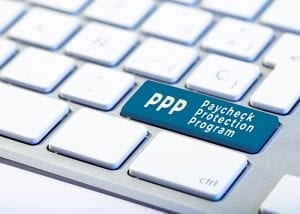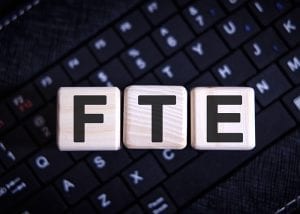Paycheck Protection Program Loan Forgiveness Application
 On Friday, May 15, 2020, the Small Business Administration released it’s much anticipated Paycheck Protection Program (PPP) Loan Forgiveness Application. While this application helps resolve several key issues and questions that have resulted from the initial loan forgiveness provision of the PPP, there continues to be elements of uncertainty and additional questions. Please refer back to this page for ongoing guidance on the document, itself, as well as the actual application process. We will continue to update this page as additional details are revealed and more is known.
On Friday, May 15, 2020, the Small Business Administration released it’s much anticipated Paycheck Protection Program (PPP) Loan Forgiveness Application. While this application helps resolve several key issues and questions that have resulted from the initial loan forgiveness provision of the PPP, there continues to be elements of uncertainty and additional questions. Please refer back to this page for ongoing guidance on the document, itself, as well as the actual application process. We will continue to update this page as additional details are revealed and more is known.
Click the button below to open the official PPP Loan Forgiveness Application and instructions. Once opened, you will have the option to print or download it to your device.
DOWNLOAD THE APPLICATION
DOWNLOAD THE AICPA'S PPP LOAN FORGIVENESS CALCULATOR
About The Application
Business Costs Eligible For Forgiveness
 There have been a lot of questions regarding which business-related costs are eligible for forgiveness under the PPP program. According to the application, generally speaking, you are eligible for loan forgiveness for payroll costs paid and payroll costs incurred during the eight-week (56-day) covered period.
There have been a lot of questions regarding which business-related costs are eligible for forgiveness under the PPP program. According to the application, generally speaking, you are eligible for loan forgiveness for payroll costs paid and payroll costs incurred during the eight-week (56-day) covered period.
Important: Your eight-week period starts on the date that your loan is received. For example, if you received your company’s PPP Loan on Friday, April 10, 2020, then the last day of your eight-week period will land on Thursday, June 4, 2020.
Payroll Costs
The SBA has opted to utilize a hybrid cash/accrual basis of accounting for the eight-week period outlined in the PPP Loan Forgiveness Application as it relates to both payroll and nonpayroll costs. Therefore, the pre-payment of any qualified expenses will not be allowed. That being said, employers will be allowed to include any payroll costs paid during the 8-week period (even if they were incurred prior to the eight week period), as well as payroll costs incurred during the eight-week period, including any incurred but unpaid payroll costs during the 8-week period as long as wages were paid on or before the next regular payroll date. We’ve provide some additional points of interest below:
- For payroll purposes only, employers can elect to use an alternative payroll covered period that mirrors the payroll cycle closest to their eight-week period.
- For each individual employee, the total amount of cash compensation eligible for forgiveness may not exceed an annual salary of $100,000, as prorated for the covered period. This means that the gross compensation is limited to $15,385 for any employee during the eight-week period.
- The employer portion of health care and retirement benefits include the amounts paid during the 8-week period or incurred during the 8-week period and paid on or before the next payroll date.
- Health care benefits – can be expenses related to providing fully insured (premiums) or self-insured benefits (presumably claims, admin fees, and stop-loss premium, and possibly other related expenses)
- Retirement benefits – The basis of accounting adopted for the 8-week period effectively eliminates any 2020 retirement benefits earned after the 8-week period, such as discretionary profit sharing and cash balance plan contributions.
- Workers' compensation premium is not includable. The instructions specifically reference only state payroll-related taxes.
- State-related payroll taxes are includable
Nonpayroll Costs
 While the primary purpose of the PPP, is to ensure that employers can continue to pay their employees, a portion of the PPP Loan can also be used to offset other eligible nonpayroll costs that were paid during the eight-week period (even if the costs were incurred prior to the eight-week period), as well as costs incurred during the eight-week period, including any incurred but unpaid costs during the eight-week period if paid on or before the next regular due date. However, these costs, for the purpose of loan forgiveness, cannot be more than 25 percent of the total loan forgiveness amount.
While the primary purpose of the PPP, is to ensure that employers can continue to pay their employees, a portion of the PPP Loan can also be used to offset other eligible nonpayroll costs that were paid during the eight-week period (even if the costs were incurred prior to the eight-week period), as well as costs incurred during the eight-week period, including any incurred but unpaid costs during the eight-week period if paid on or before the next regular due date. However, these costs, for the purpose of loan forgiveness, cannot be more than 25 percent of the total loan forgiveness amount.
Nonpayroll costs that are eligible for forgiveness are:
- Covered mortgage obligations, which include payments of interest (not including prepayment or payment of principal) on any business mortgage obligation on real or personal property incurred before Feb. 15, 2020.
- Covered rental obligations, which include business rent or lease payments pursuant to lease agreements for real or personal property in force prior to Feb. 15, 2020 (no limitation yet for lease payments made to related parties or rental payments for equipment).
- Covered utility payments, including business payments for distribution of electricity, gas, water, transportation, telephone, or internet access for which service began before Feb. 15, 2020.
DOWNLOAD THE AICPA'S PPP LOAN FORGIVENESS CALCULATOR
PPP Loan Forgiveness Reductions For Consideration
 The release of the SBA’s PPP Loan Forgiveness Application provides us with much-needed guidance when it comes to determining not only which costs will be forgiven, but how forgiveness will be calculated. The document also provides us with insight into key forgiveness reductions employers should keep top-of-mind. For your information, we’ve outlined two key PPP loan forgiveness reductions below.
The release of the SBA’s PPP Loan Forgiveness Application provides us with much-needed guidance when it comes to determining not only which costs will be forgiven, but how forgiveness will be calculated. The document also provides us with insight into key forgiveness reductions employers should keep top-of-mind. For your information, we’ve outlined two key PPP loan forgiveness reductions below.
- Headcount Reduction
- The full-time employee (FTE) calculation is based on an employee working 40 hours/week. For each employee, you must calculate the average number of hours paid per week, divide that number by 40, and round the total to the nearest tenth. The maximum for each employee is capped at 1.0.
- Simplified method election: assign a 1.0 for employees who work 40 hours or more per week and 0.5 for employees who work fewer hours.
- Compare your average FTEs for the eight-week covered period to average FTEs during your selected pre-crisis period.
- Your forgiveness amount will be limited to the forgiveness amount multiplied by the quotient of: Your average FTE during the eight-week period/your average FTE during the pre-crisis period chosen.
- The full-time employee (FTE) calculation is based on an employee working 40 hours/week. For each employee, you must calculate the average number of hours paid per week, divide that number by 40, and round the total to the nearest tenth. The maximum for each employee is capped at 1.0.
- Salary/Wage Reduction
- For the purposes of loan forgiveness reductions, only employees who had gross compensation reduced by more than 25 percent during the eight-week period will be considered.
- You will use the first quarter of 2020 (Jan. 1, 2020 to March 31, 2020) as your comparison period.
- The reduction will be based on the employee’s average annual salary or wage.
- This reduction will equal the sum of each employee with a pro-rated annual average compensation reduction greater than 25 percent during the covered eight-week period. See the instructions for more detailed guidance.
REMINDER: Any loan proceeds not used during the eight-week period on the specified expenses listed above will not be forgiven.
DOWNLOAD THE AICPA'S PPP LOAN FORGIVENESS CALCULATOR
Forgiveness Safe Harbors
 While the SBA has released guidelines that state the amount of an employer’s PPP loan forgiveness will be reduced if they reduce the business’s headcount during the covered period or if they see a salary/wage reduction due to the crisis, this will not be the case if a safe harbor is met. In addition to calculating your FTEs during the covered period, you will also be required to calculate FTEs for two additional periods:
While the SBA has released guidelines that state the amount of an employer’s PPP loan forgiveness will be reduced if they reduce the business’s headcount during the covered period or if they see a salary/wage reduction due to the crisis, this will not be the case if a safe harbor is met. In addition to calculating your FTEs during the covered period, you will also be required to calculate FTEs for two additional periods:
- The period from Feb. 15, 2020, through April 26, 2020
- For the pay period that includes Feb. 15, 2020
Once you have this information, according to the SBA, if the average FTEs for the first period is fewer than the FTEs for the second period, you must then compare your average FTEs for the second period to your total FTEs come June 30, 2020. What the SBA is looking for is for your FTEs on June 30, 2020, to be the same or greater than the number of FTEs you had on Feb. 15, 2020. Ultimately, they want you to show that your business has bounced back and is operating at pre-COVID-19 levels.
It appears that the safe harbor for the wage reduction factor is simply comparing the annualized wage/salary for each employee during the payroll that includes June 30 to the annualized wage/salary for the payroll that contains Feb 15. As long as the June 30 annualized wage is at least as much as the Feb 15 annualized wage, the safe harbor is met for that employee.
Finally, your loan forgiveness amount will not be reduced if you can show that any FTE reduction was due to circumstances outside of your control. Specifically that during the eight-week period:
- You made a good-faith, written offer to rehire an employee that was rejected by the employee.
- The employee that was fired for cause.
- The employee voluntarily resigned
- The employee voluntarily requested and received a reduction of hours.
Tony Nitti wrote a very detailed and informative article for Forbes on this topic that examines the PPP Loan Forgiveness Application, complete with examples and calculations. Check it out here for additional clarity.
Also, note that there may be some legislative changes resulting from intense lobbying by certain industries. In particular:
- The 8-week period may be extended, and
- The 75% payroll cost requirement may be relaxed, and
- The IRS position regarding the non-deductibility of expenses related to the PPP loan forgiveness may be overridden by specific legislation.
PPP Loan Forgiveness Application Help
You don’t have to tackle this project alone. The PPP Loan Forgiveness Application has many parts and is very complicated, but resources are available to help you collect and calculate the required information. The Rea & Associates COVID-19 Task Force is available to answer any question you may have. Email our team of experts today to speak with a member of our team or click the button below to begin the PPP Loan Forgiveness Application Process.
